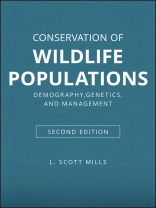Population ecology has matured to a sophisticated science with
astonishing potential for contributing solutions to wildlife
conservation and management challenges. And yet, much of the
applied power of wildlife population ecology remains untapped
because its broad sweep across disparate subfields has been
isolated in specialized texts. In this book, L. Scott Mills
covers the full spectrum of applied wildlife population ecology,
including genomic tools for non-invasive genetic sampling,
predation, population projections, climate change and invasive
species, harvest modeling, viability analysis, focal species
concepts, and analyses of connectivity in fragmented landscapes.
With a readable style, analytical rigor, and hundreds of examples
drawn from around the world, Conservation of Wildlife
Populations (2nd ed) provides the conceptual basis
for applying population ecology to wildlife conservation
decision-making. Although targeting primarily undergraduates
and beginning graduate students with some basic training in basic
ecology and statistics (in majors that could include wildlife
biology, conservation biology, ecology, environmental studies, and
biology), the book will also be useful for practitioners in the
field who want to find – in one place and with plenty of applied
examples – the latest advances in the genetic and demographic
aspects of population ecology.
Additional resources for this book can be found at: href=’http://www.wiley.com/go/mills/wildlifepopulations’>www.wiley.com/go/mills/wildlifepopulations.
astonishing potential for contributing solutions to wildlife
conservation and management challenges. And yet, much of the
applied power of wildlife population ecology remains untapped
because its broad sweep across disparate subfields has been
isolated in specialized texts. In this book, L. Scott Mills
covers the full spectrum of applied wildlife population ecology,
including genomic tools for non-invasive genetic sampling,
predation, population projections, climate change and invasive
species, harvest modeling, viability analysis, focal species
concepts, and analyses of connectivity in fragmented landscapes.
With a readable style, analytical rigor, and hundreds of examples
drawn from around the world, Conservation of Wildlife
Populations (2nd ed) provides the conceptual basis
for applying population ecology to wildlife conservation
decision-making. Although targeting primarily undergraduates
and beginning graduate students with some basic training in basic
ecology and statistics (in majors that could include wildlife
biology, conservation biology, ecology, environmental studies, and
biology), the book will also be useful for practitioners in the
field who want to find – in one place and with plenty of applied
examples – the latest advances in the genetic and demographic
aspects of population ecology.
Additional resources for this book can be found at: href=’http://www.wiley.com/go/mills/wildlifepopulations’>www.wiley.com/go/mills/wildlifepopulations.
Table of Content
List of boxes ixPreface to second edition xi
Preface to first edition xii
List of symbols xiv
Acknowledgments for second edition xv
Acknowledgments for first edition xvi
PART I BACKGROUND TO APPLIED POPULATION BIOLOGY 1
1 The big picture: human population dynamics meet applied population biology 3
2 Designing studies and interpreting population biology data: how do we know what we know? 14
3 Genetic concepts and tools to support wildlife population biology 33
4 Estimating population vital rates 54
PART II POPULATION PROCESSES: THE BASIS FOR MANAGEMENT 77
5 The simplest way to describe and project population growth: exponential or geometric
change 79
6 All stage classes are not equal in their effects on population growth: structured
population-projection models 98
7 Density-dependent population change 126
8 Predation and wildlife populations 142
9 Genetic variation and fi tness in wildlife populations 154
10 Dynamics of multiple populations 175
PART III APPLYING KNOWLEDGE OF POPULATION PROCESSES TO PROBLEMS OF DECLINING, SMALL, OR HARVESTABLE POPULATIONS 199
11 Human-caused stressors: deterministic factors affecting populations 201
12 Predicting the dynamics of small and declining populations 224
13 Focal species to bridge from populations to ecosystems 244
14 Population biology to guide sustainable harvest 251
Summary 266
Further Reading 267
Epilogue 269
References 271
Index 301
Colour Plates fall between page 160 and 1
About the author
L. Scott Mills is a Professor in the Wildlife BiologyProgram at The University of Montana. He was a 2009 John Simon
Guggenheim Fellow, has received multiple NSF Awards, served on the Board of Governors for the North American Section of the Society for Conservation Biology, and has testified to Congress about the role of ethics in wildlife population biology research. Mills was an invited contributor to the 2007 Intergovernmental Panel on Climate Change Report (IPCC) report, and to the Western
Governors? Association Climate Change Working Group. His research and teaching integrates field studies with population
models and genetic analyses to understand effects of human
perturbations on wildlife populations. Mills’ research on wildlife around the world ? from snowshoe hares to marmots, mice to coyotes, bighorn sheep to snow leopards and tigers – has been
covered in media outlets including Newsweek, National
Geographic, The New York Times, Discovery Channel Canada, Science News, National Public Radio, Nature, Science, and The Nature of Things with David Suzuki.
Language English ● Format EPUB ● Pages 352 ● ISBN 9781118406670 ● File size 7.0 MB ● Publisher John Wiley & Sons ● Published 2012 ● Edition 2 ● Downloadable 24 months ● Currency EUR ● ID 2589248 ● Copy protection Adobe DRM
Requires a DRM capable ebook reader











![Cover of [加]史蒂文·厄尔: 地球气候简史 Cover of [加]史蒂文·厄尔: 地球气候简史](https://static.world-of-digitals.com/thumb_webp/226/9798869051226.webp)
